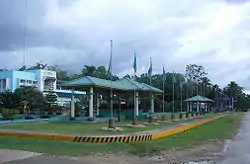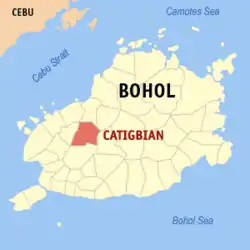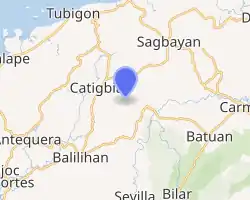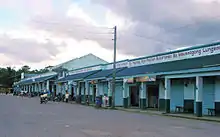Catigbian
Catigbian, officially the Municipality of Catigbian (Cebuano: Lungsod sa Catigbian; Tagalog: Bayan ng Catigbian), is a 4th class municipality in the province of Bohol, Philippines. According to the 2015 census, it has a population of 22,675 people. [3]
Catigbian | |
|---|---|
| Municipality of Catigbian | |
 Catigbian Town Hall | |
 Map of Bohol with Catigbian highlighted | |
OpenStreetMap 
| |
.svg.png.webp) Catigbian Location within the Philippines | |
| Coordinates: 9°50′N 124°02′E | |
| Country | |
| Region | Central Visayas (Region VII) |
| Province | Bohol |
| District | 1st District |
| Founded | 17 June 1949 |
| Barangays | 22 (see Barangays) |
| Government | |
| • Type | Sangguniang Bayan |
| • Mayor | Elizabeth E. Mandin |
| • Vice Mayor | Esteban N. Angilan Jr. |
| • Representative | Edgardo M. Chatto |
| • Electorate | 15,603 voters (2019) |
| Area | |
| • Total | 113.33 km2 (43.76 sq mi) |
| Elevation | 217 m (712 ft) |
| Population | |
| • Total | 22,675 |
| • Density | 200/km2 (520/sq mi) |
| • Households | 5,117 |
| Economy | |
| • Income class | 4th municipal income class |
| • Poverty incidence | 29.2% (2015)[4] |
| • Revenue | ₱78,366,634.15 (2016) |
| Time zone | UTC+8 (PST) |
| ZIP code | 6343 |
| PSGC | |
| IDD : area code | +63 (0)38 |
| Climate type | tropical monsoon climate |
| Native languages | Boholano dialect Cebuano Tagalog |
Catigbian was formerly known as San Jacinto, and officially changed to its current name in 1954.[5] Catigbian is named after a certain group of seed-bearing plants named "Katigbi" (Coix lacrymajobi), which grow abundantly.[6]
History
The town was founded in 1829 as one of the villages where rebels were resettled after the Dagohoy Rebellion had been suppressed. In 1903, when the province was reorganized, it was annexed to Balilihan but was made an independent municipality once more on 17 June 1949.[7] At that time there were only 15 barrios within the territorial limits compared to the 22 barangays it has now.
Geography
Located 35 kilometres (22 mi) north of Tagbilaran, Catigbian is an interior town north of Balilihan, south of Sagbayan and Tubigon, east of San Isidro and west of Batuan.
Barangays
Catigbian comprises 22 barangays:
| PSGC | Barangay | Population | ±% p.a. | |||
|---|---|---|---|---|---|---|
| 2015 [3] | 2010 [8] | |||||
| 071213001 | Alegria | 5.5% | 1,248 | 1,247 | 0.02% | |
| 071213002 | Ambuan | 5.1% | 1,150 | 1,197 | −0.76% | |
| 071213003 | Baang | 6.4% | 1,442 | 1,381 | 0.83% | |
| 071213004 | Bagtic | 4.7% | 1,055 | 1,069 | −0.25% | |
| 071213005 | Bonbong | 2.5% | 565 | 579 | −0.46% | |
| 071213007 | Cambailan | 3.3% | 759 | 916 | −3.52% | |
| 071213008 | Candumayao | 7.1% | 1,600 | 1,545 | 0.67% | |
| 071213011 | Causwagan Norte | 7.8% | 1,763 | 1,812 | −0.52% | |
| 071213013 | Hagbuaya | 3.2% | 718 | 875 | −3.70% | |
| 071213014 | Haguilanan | 4.8% | 1,094 | 1,133 | −0.66% | |
| 071213009 | Kang‑iras | 3.2% | 724 | 709 | 0.40% | |
| 071213015 | Libertad Sur | 1.4% | 326 | 364 | −2.08% | |
| 071213016 | Liboron | 4.2% | 954 | 930 | 0.49% | |
| 071213017 | Mahayag Norte | 2.4% | 551 | 577 | −0.87% | |
| 071213018 | Mahayag Sur | 1.2% | 277 | 277 | 0.00% | |
| 071213019 | Maitum | 4.0% | 896 | 1,035 | −2.71% | |
| 071213020 | Mantasida | 4.4% | 1,001 | 913 | 1.77% | |
| 071213021 | Poblacion | 8.1% | 1,848 | 1,810 | 0.40% | |
| 071213027 | Poblacion Weste | 7.7% | 1,754 | 1,742 | 0.13% | |
| 071213022 | Rizal | 3.1% | 700 | 694 | 0.16% | |
| 071213025 | Sinakayanan | 4.0% | 913 | 733 | 4.27% | |
| 071213026 | Triple Union | 5.1% | 1,149 | 1,148 | 0.02% | |
| Total | 22,675 | 22,686 | −0.01% | |||
Climate
| Climate data for Catigbian, Bohol | |||||||||||||
|---|---|---|---|---|---|---|---|---|---|---|---|---|---|
| Month | Jan | Feb | Mar | Apr | May | Jun | Jul | Aug | Sep | Oct | Nov | Dec | Year |
| Average high °C (°F) | 26 (79) |
27 (81) |
28 (82) |
30 (86) |
30 (86) |
29 (84) |
29 (84) |
29 (84) |
29 (84) |
28 (82) |
27 (81) |
27 (81) |
28 (83) |
| Average low °C (°F) | 22 (72) |
21 (70) |
22 (72) |
22 (72) |
23 (73) |
23 (73) |
23 (73) |
23 (73) |
23 (73) |
23 (73) |
22 (72) |
22 (72) |
22 (72) |
| Average precipitation mm (inches) | 98 (3.9) |
82 (3.2) |
96 (3.8) |
71 (2.8) |
104 (4.1) |
129 (5.1) |
101 (4.0) |
94 (3.7) |
99 (3.9) |
135 (5.3) |
174 (6.9) |
143 (5.6) |
1,326 (52.3) |
| Average rainy days | 18.0 | 14.1 | 17.1 | 16.8 | 23.7 | 25.7 | 25.8 | 23.3 | 24.2 | 25.9 | 24.0 | 20.6 | 259.2 |
| Source: Meteoblue (modeled/calculated data, not measured locally) [9] | |||||||||||||
Demographics
|
| |||||||||||||||||||||||||||||||||||||||
| Source: Philippine Statistics Authority [3] [8] [10][11] | ||||||||||||||||||||||||||||||||||||||||
Economy

Commerce and industry
- Catigbian Public Market
- Livestock Auction Center – the biggest in the province of Bohol
- Abattoir
- Catigbian Waterworks System
- One Town One Product (OTOP) Display Center
Agriculture
- 8,950 ha (22,100 acres) alienable & disposable land
- 43.85% devoted to crops
- 56.15% pasture land, grassland, idle land
- 2,351 ha (5,809 acres) forestal land
- Livestock raising (alternative)
Infrastructure
Water
- 3 Pumping Stations for 12 barangays – 500 m3 (130 thousand US gallons) /day
- 2 more barangays with own pumping station
Facilities
- Catigbian Training Center
- Municipal Court Hall
- Municipal Conference Hall
- Public Market
- Tennis Court
- Basketball Court/Multi-Purpose Court (sports and other activities)
- Catigbian District Hospital
- Municipal Health Center
Feast Days & Patron Saints
Catigbian comprises two parishes:
- Immaculate Conception Parish (church located in Poblacion West), which celebrates its Feast Day on 8 December in honor of the Immaculate conception of the Virgin Mary[12]
- Santo Niño Parish (church located in Baang), which celebrates its feast day on the third Saturday of January in honor of the Holy Child Jesus
Tourism
Catigbian is home to caves, hanging bridges, handicrafts, livestock market and for its nature resort. Among its attractions are
- Betn'Choy Farms and Resort
- Rizal Hanging Bridge
- Cantalina Cave
- Haguilanan Cave
- Candumayao Cave
- Bongbong Cave
- Dagook Falls
The Katigbawan Festival
What distinguishes Catigbian from other towns is its annual festival, the Katigbawan, which is a week-long festival in June consisting of various activities like carabao-racing, hog-catching, agrofair, motorcross and a search for Miss Katigbawan.
This four-day event has several activities lined up starting with the opening of the festival with a parade after a holy mass. It is followed by a comparza and a talent contest of Miss Katigbawan candidates during the day. Judging of the display of agrofair, bloodletting and motorcross takes place on the second day. On the third day is the Carabao Parade with carabao-racing and hog-catching at central elementary school and the search for Catigbian's prettiest – the Miss Katigbawan Beauty Pageant – in the evening.[lower-alpha 1] On the fourth day is the street dancing, then a fireworks display to cap the festival.
Education
Literacy Rate: 87.9%
- 1 Tertiary School
- Bohol Northwestern Colleges
-
- Catigbian National High School
- Haguilanan High School
- Hagbuaya High School
- Holy Infant Academy
- Immaculate Mary Academy
- Mahayag High School
- Mantacida National High School
- 19 Public Elementary Schools
- 3 Primary Schools
- 22 Day Care Centers
Notes
- A beauty and brains search for the girl best exemplifying the true Catigbianon. The winner represents the town in the province's most prestigious pageant – Miss Bohol Sandugo – held in July
References
- Municipality of Catigbian | (DILG)
- "Province: Bohol". PSGC Interactive. Quezon City, Philippines: Philippine Statistics Authority. Retrieved 12 November 2016.
- Census of Population (2015). "Region VII (Central Visayas)". Total Population by Province, City, Municipality and Barangay. PSA. Retrieved 20 June 2016.
- "PSA releases the 2015 Municipal and City Level Poverty Estimates". Quezon City, Philippines. Retrieved 12 October 2019.
- Republic Act No. 1032 (12 June 1954), An Act Changing the Name of the Municipality of San Jacinto, Province of Bohol, to Catigbi-an
- "Municipality of Catigbian". Province of Bohol. Retrieved 30 January 2015.
- Executive Order No. 229 (17 June 1949), ORGANIZING CERTAIN PORTIONS OF THE MUNICIPALITIES OF BALILIHAN, ANTEQUERA AND TUBIGON, ALL OF THE PROVINCE OF BOHOL, INTO AN INDEPENDENT MUNICIPALITY UNDER THE NAME OF SAN JACINTO. (PDF)
- Census of Population and Housing (2010). "Region VII (Central Visayas)". Total Population by Province, City, Municipality and Barangay. NSO. Retrieved 29 June 2016.
- "Catigbian: Average Temperatures and Rainfall". Meteoblue. Retrieved 9 May 2020.
- Censuses of Population (1903–2007). "Region VII (Central Visayas)". Table 1. Population Enumerated in Various Censuses by Province/Highly Urbanized City: 1903 to 2007. NSO.
- "Province of Bohol". Municipality Population Data. Local Water Utilities Administration Research Division. Retrieved 17 December 2016.
- "Catigbian Destination Guide". "www.bohol-philippines.com". Retrieved 2019-04-15.
External links
| Wikimedia Commons has media related to Catigbian, Bohol. |